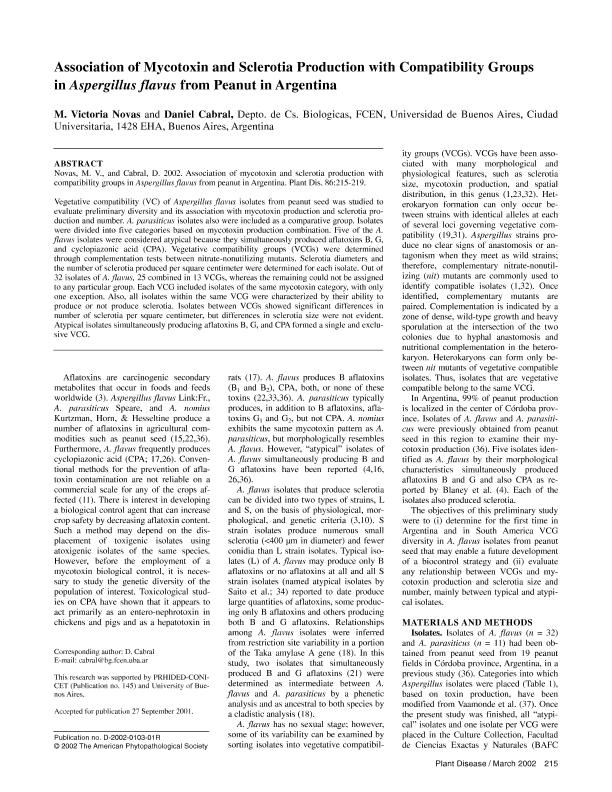Artículo
Association of Mycotoxin and Sclerotia Production with Compatibility Groups in Aspergillus flavus from Peanut in Argentina
Fecha de publicación:
03/2002
Editorial:
American Phytopathological Society
Revista:
Plant Disease
ISSN:
0191-2917
e-ISSN:
1943-7692
Idioma:
Inglés
Tipo de recurso:
Artículo publicado
Clasificación temática:
Resumen
Vegetative compatibility (VC) of Aspergillus flavus isolates from peanut seed was studied to evaluate preliminary diversity and its association with mycotoxin production and sclerotia production and number. A. parasiticus isolates also were included as a comparative group. Isolates were divided into five categories based on mycotoxin production combination. Five of the A. flavus isolates were considered atypical because they simultaneously produced aflatoxins B, G, and cyclopiazonic acid (CPA). Vegetative compatibility groups (VCGs) were determined through complementation tests between nitrate-nonutilizing mutants. Sclerotia diameters and the number of sclerotia produced per square centimeter were determined for each isolate. Out of 32 isolates of A. flavus, 25 combined in 13 VCGs, whereas the remaining could not be assigned to any particular group. Each VCG included isolates of the same mycotoxin category, with only one exception. Also, all isolates within the same VCG were characterized by their ability to produce or not produce sclerotia. Isolates between VCGs showed significant differences in number of sclerotia per square centimeter, but differences in sclerotia size were not evident. Atypical isolates simultaneously producing aflatoxins B, G, and CPA formed a single and exclusive VCG.
Archivos asociados
Licencia
Identificadores
Colecciones
Articulos(INMIBO (EX - PROPLAME))
Articulos de INSTITUTO DE MICOLOGIA Y BOTANICA
Articulos de INSTITUTO DE MICOLOGIA Y BOTANICA
Citación
Novas, María Victoria; Cabral, Daniel; Association of Mycotoxin and Sclerotia Production with Compatibility Groups in Aspergillus flavus from Peanut in Argentina; American Phytopathological Society; Plant Disease; 86; 3; 3-2002; 215-219
Compartir
Altmétricas




